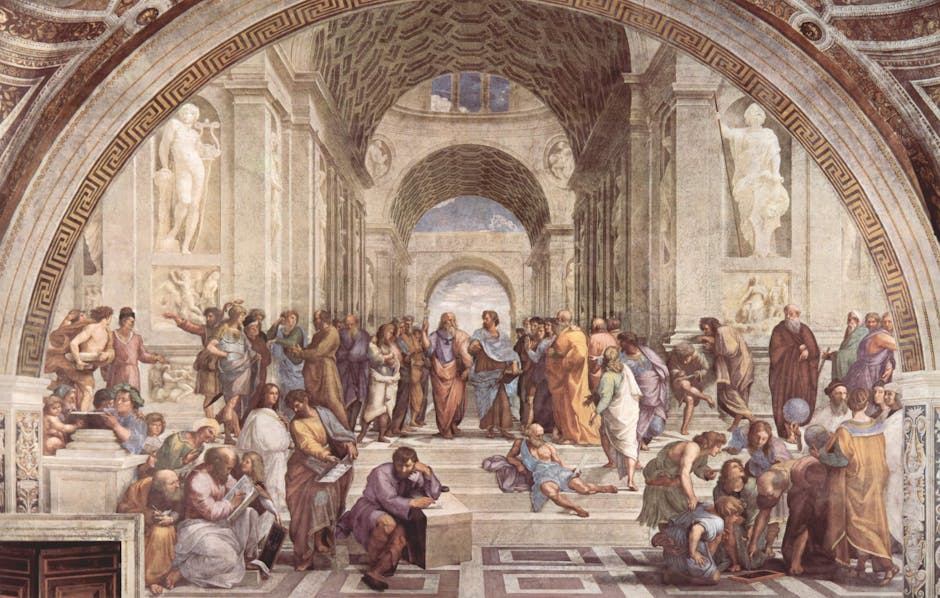It’s easy to forget that centuries before Socrates, Plato, and Aristotle left their indelible marks, a world of philosophical thought was already quietly taking shape. Presocratic philosophy emerged from a time when myth reigned supreme, offering something radical: an attempt to explain the universe through reason rather than divine will. These thinkers didn’t just ask questions; they redefined what it meant to wonder, to observe, to seek clarity in the chaos of the natural world. From the Milesians pondering the essence of all things to Heraclitus’s insistence on perpetual change, their inquiries became the foundation upon which Western philosophy now stands.
By tracing their ideas and influence chronologically, we can see how their work evolved—not in isolation, but as a connected mosaic of human curiosity. They weren’t just looking at the stars or dissecting existence; they were building a framework for how we still think today. If Socratic reasoning is the house, Presocratic thought is the cornerstone, weathered yet unyielding. In their questions about the cosmos, matter, and life itself, they gave us something far more enduring than answers: the ability to keep asking.
Table of Contents
The Birth of Presocratic Philosophy: Early Thinkers of Miletus
When we think about philosophy’s beginnings, the name “Miletus” often rises to the forefront—a small yet profoundly significant city in Ionia, now modern-day Turkey. Here, a group of thinkers began asking questions that broke from the mythological explanations of their time. They stripped the gods from the center of the universe and replaced them with inquisitiveness, seeking naturalistic and rational explanations for the world around them. This shift wasn’t just monumental; it was the spark that ignited centuries of philosophical discovery. Let’s explore the contributions of three pivotal figures of the Milesian School: Thales, Anaximander, and Anaximenes.
Thales of Miletus (c. 624–546 BCE)
Thales is often celebrated as the father of Western philosophy. His revolutionary idea that the cosmos could be understood through natural principles rather than divine intervention set an intellectual trajectory that would unfold for generations. Thales proposed that water was the fundamental principle (arche) of all things. Imagine a world where myths dominated explanations, then suddenly someone posits that life could emerge from something as practical and observable as water. It must have been thrilling—a revelation that changed thinking itself.
He wasn’t just a philosopher, though. Thales made strides in mathematics, famously calculating the height of pyramids using their shadows, and is even attributed to introducing geometry to Greece. In astronomy, he’s said to have predicted a solar eclipse in 585 BCE, illustrating a profound understanding of celestial patterns. His observations marked the beginning of a shift toward methodological inquiry over superstition. Learn more about Thales’s contributions here.
Anaximander (c. 610–546 BCE)
Standing on the intellectual shoulders of Thales, Anaximander had his own daring ideas. He proposed that the origin of all things wasn’t something as tangible as water but something less defined—what he called the apeiron. This “boundless” or “infinite” substance, according to Anaximander, was eternal and indestructible, a limitless source from which all things arise and eventually return. His reasoning stretched the imagination, offering what may be considered one of the earliest contemplations of infinity.
Where Anaximander truly distinguished himself, though, was in his approach to astronomy and natural sciences. He created the first known map of the Earth, an extraordinary attempt to depict the inhabited world. His use of geometry to construct tools like the gnomon, a device that could measure time and seasons, exemplified his innovative spirit. It’s fascinating how his work signaled the beginning of systematic, scientific thinking. Dive deeper into Anaximander’s work here.
Anaximenes (c. 585–528 BCE)
If Thales made water fundamental and Anaximander revealed the infinite, Anaximenes sought deeper clarity. He proposed that air was the primary substance of the cosmos. But air, to him, wasn’t just what we breathe; it was something more dynamic and transformative. Anaximenes explained change through processes of condensation and rarefaction—concepts that resonate with modern physics in their simplicity. For example, compressed air might form water, which could then solidify into stone.
Anaximenes also extended his inquiries into cosmology, exploring how the heavens connected to earthly existence. His ideas left a lasting impression on theories of natural change and continuity, influencing later Presocratic thinkers. His work shows how interconnected philosophy and early science truly were, as each idea built on observable phenomena. Discover more about Anaximenes and his philosophy here.
The Milesian School wasn’t just the birthplace of Presocratic philosophy; it was the beginning of a new way of thinking. In unearthing not just “what” but “why,” these thinkers began the journey from myth to reason—a journey that has defined humanity’s quest for understanding ever since.
Pythagoras and the Pythagoreans: Philosophy Through Mathematics
Pythagoras of Samos and his followers weren’t just mathematicians; they were seekers of universal truths, bridging the profound connection between numbers and the cosmos itself. They treated mathematics with almost mystical significance, believing it was the thread weaving together the fabric of existence. Let’s explore what Pythagoras himself contributed and how his school carried forward his legacy.
Pythagoras of Samos (c. 570-497 BCE)
Pythagoras is one of those figures whose contributions are so foundational that, even today, his influence feels ever-present. Most of us know him for the Pythagorean Theorem, the mathematical rule etched into every geometry textbook. But to reduce Pythagoras to a single equation would be like summarizing the ocean with just one wave—it’s only a glimpse into his vast impact.
Pythagoras believed that numbers were the essence of all things. To him, the universe didn’t just move in patterns; it was a pattern, written in numeric precision. For Pythagoras, numbers had personalities, almost like characters in a grand cosmic play. He argued that mathematics wasn’t merely a tool for problem-solving—it was the language of reality itself. This belief extended to astronomy, music, and even ethics.
The concept of numerical harmony defined much of his work. Pythagoras discovered that musical notes could be expressed mathematically through ratios. For instance, when a string was divided to produce specific lengths, the sounds it created aligned perfectly with particular numerical proportions. This was a revelation: an audible and tangible manifestation of the beauty of numbers.
Beyond math, Pythagoras’ ideas touched on spirituality. He famously endorsed the idea of the immortality of the soul and believed in its reincarnation—a cycle he claimed could be broken through knowledge and purity of life. Philosophy, science, and morality weren’t separate endeavors to him; they were interwoven aspects of the same quest for truth. Learn more about his philosophies and influences here.
The Pythagorean School
Pythagoras didn’t work in isolation. In fact, he founded a community—the Pythagorean School—that blurred the line between academia and asceticism. Located in Croton (modern-day southern Italy), this was not only a school but also a way of life. Its members adhered to strict ethical standards, dietary restrictions (many avoided eating meat), and a shared pursuit of knowledge with almost religious dedication.
The Pythagoreans saw mathematics as sacred, believing it held the keys to unlocking the universe. Central to their teachings was the idea of the music of the spheres—the belief that celestial bodies like the sun, moon, and planets produced a kind of symphony as they moved through the cosmos. They imagined the heavens not as silent voids but as orchestrated realms, harmonizing beautifully via mathematical laws. While modern science has largely discarded the literal notion of this celestial music, the core idea—that the universe operates with an intrinsic order—has endured.
From a practical standpoint, the Pythagoreans advanced the field of geometry considerably. They were among the first to treat mathematics as something abstract and theoretical—not just a tool for merchants or builders. Their studies on proportions, magnitudes, and the properties of numbers laid the groundwork for what we now consider pure math.
One of the most fascinating aspects of the Pythagorean worldview was how deeply their beliefs blurred the distinction between science, philosophy, and spirituality. For them, contemplating the structure of a triangle wasn’t just academic; it bordered on reverence. Numbers weren’t just symbols—they were the very essence of existence. Explore the Pythagorean School’s contributions here.
In their collective legacy, the Pythagoreans remind us that there’s something profoundly human about finding order in chaos. To hold a number in your hand—or better yet, in your mind—is to touch something eternal.
Heraclitus and Parmenides: Contrasting Views on Change and Being
The debate between change and permanence has deep roots in philosophy’s early days, and no two thinkers personify this intellectual crossroads better than Heraclitus and Parmenides. At heart, their contrasting worldviews set the stage for centuries of philosophical exploration. Let’s look at how Heraclitus embraced the constant flux of existence, while Parmenides stood firmly for unchanging unity—and how a third figure, Zeno, joined the fray to defend Parmenides with his famous paradoxes.
Heraclitus of Ephesus (c. 535-475 BCE)
Heraclitus, often known as the “philosopher of change,” believed in a world that never stood still. His most famous observation—”No man ever steps in the same river twice, for it’s not the same river, and he’s not the same man”—is more than poetic. It’s a profound commentary on existence itself. To Heraclitus, everything we encounter in life is in a constant state of flux. Even something as seemingly static as a stone is subject to the forces of time, wear, and transformation.
Central to Heraclitus’s philosophy is the concept of the logos—a guiding principle underlying all change. The logos isn’t chaos; it’s the thread that ties everything together. Think of it as a cosmic rhythm, a balance within the disorder. Heraclitus saw fire as a metaphor for this dynamic process, representing energy, transformation, and renewal. The world, he believed, thrives on conflict and contradiction—the interplay of opposites forging harmony.
His ideas may seem abstract, but they resonate deeply if you think about the cycles of life. Isn’t growth born out of struggle, and understanding sculpted by experience? For Heraclitus, this was the very essence of reality. Discover more about Heraclitus’s philosophy here.
Parmenides of Elea (c. 515 BCE)
Where Heraclitus saw motion, Parmenides saw stillness. To Parmenides, change was not only an illusion but an impossibility. Imagine for a moment a reality where nothing truly alters: everything simply is. Parmenides argued that being is unified, eternal, and unchanging—an indivisible whole. This wasn’t a dismissal of reality but a rejection of sensory appearances. What we perceive as change, he claimed, is a distortion, a trick played by our senses.
In his cryptic poem, “On Nature,” Parmenides lays out his reasoning: What exists has always existed and will always exist. To think otherwise leads to a logical contradiction. How can something come from nothing? And if something is not, how can it even be discussed or thought about? For Parmenides, the very act of reasoning demanded a firm, unchanging foundation—being.
His philosophy is radical and challenging, but it forces us to question how much we trust our perceptions. Are the shifts and changes we witness real, or just how our minds frame the unchanging truth? It’s no surprise that his views revolutionized metaphysics. Read more about Parmenides and his philosophy here.
Zeno of Elea (c. 490-430 BCE)
Zeno, a devoted follower of Parmenides, took it upon himself to defend his mentor’s ideas. He didn’t just defend with words—he presented puzzles, paradoxes that challenged the very foundations of logic and motion. Perhaps the most famous of these is the paradox of Achilles and the tortoise: if Achilles gives the tortoise a head start in a race, Zeno argues that Achilles will never catch up because he must first reach the point where the tortoise began. By the time he gets there, the tortoise will have moved further, and so on, infinitely.
What’s the point of this mind-bending scenario? Zeno wasn’t denying motion; rather, he was revealing its contradictions when viewed through the lens of plurality and division. If we break reality into infinite parts, as our senses suggest, then logical problems arise. For Zeno, these paradoxes served to underscore Parmenides’ assertion that reality was a single, unchanging entity.
The brilliance of Zeno’s work lies in how it forces us to wrestle with contradictions between intuition and logic. Even today, his paradoxes intrigue mathematicians and philosophers alike, raising questions about the nature of time, space, and infinity. Explore Zeno’s paradoxes and their implications here.
Together, Heraclitus, Parmenides, and Zeno carved deep paths in the terrain of philosophy. Their ideas may seem at odds—constant change versus eternal stasis—but it’s in their very collision that the richness of metaphysical thought emerges. Their dialogue, immortalized in centuries of debate, reminds us that there’s more than one way to see reality—and that questioning the obvious is where philosophy truly begins.
Pluralists and Atomists: Diverse Philosophical Innovations
Breaking away from the early monistic views of thinkers like Thales and Parmenides, the pluralists and atomists introduced bold, groundbreaking ideas to the philosophical table. These thinkers challenged the notion that the essence of everything could be reduced to one single principle, opting instead for more intricate frameworks to explain the nature of existence. Their ideas not only expanded the horizons of natural philosophy but also laid crucial groundwork for scientific inquiry. Let’s dive into their contributions.
Empedocles (c. 494-434 BCE)
Empedocles stands out for creating a model of the universe that still feels strikingly poetic and imaginative, even millennia later. He rejected the idea that just one substance could account for the diversity of life. Instead, he introduced the concept of four “roots”—what we now call the classical elements: earth, air, fire, and water. According to Empedocles, these elements form the building blocks of all matter, blending together in infinite combinations to create the variety we see in the world around us.
But these elements weren’t simply drifting aimlessly. Empedocles envisioned two universal forces governing their behavior: Love and Strife. Think of them almost as cosmic dance partners—Love pulls the elements together into harmonious unions, while Strife tears them apart into disarray. This endless cycle of attraction and repulsion drives both creation and destruction. For Empedocles, the eternal interplay of these forces wasn’t just a mechanical process; it was the essence of life itself.
He also dabbled in early biology, describing human perception as a result of interactions between the “roots” and tiny physical effluences. His ideas may lack modern precision, but they reflect a sincere, almost childlike curiosity about how things work—a quality that continues to inspire us. Explore Empedocles’ philosophy and cosmic vision here.
Anaxagoras (c. 500-428 BCE)
Where Empedocles saw a dynamic tug-of-war between elemental forces, Anaxagoras looked higher—to the sky, the stars, and beyond. He introduced the idea of Nous, often translated as “Mind” or “Intellect,” as the fundamental driving force behind the cosmos. For Anaxagoras, this wasn’t just metaphorical—it was literal. Nous was a divine, intelligent principle that initiated motion, setting the chaotic, swirling mass of matter into organized patterns.
To Anaxagoras, the universe wasn’t random; everything was interconnected, guided by this overarching Mind. He proposed a radical concept of “everything-in-everything,” suggesting that every substance contains a mixture of all the basic ingredients of matter, with Nous orchestrating the combinations. It’s the philosophical equivalent of baking: imagine a cake where every crumb contains the essence of chocolate, flour, butter, and every other ingredient, just in varying amounts.
Anaxagoras also made significant inroads into natural science. He explained celestial phenomena, such as the sun being a fiery stone and eclipses being the interplay of shadow and light. These ideas might sound quaint today, but they were revolutionary for their time. His emphasis on Nous as an organizing principle pushed early philosophy closer to metaphysics and cosmology. Learn more about Anaxagoras and his theories here.
Leucippus and Democritus (c. 460-370 BCE)
Leucippus and his student Democritus founded atomism, arguably one of the most audacious theories of antiquity. They proposed that all things are composed of indivisible, indestructible units called atoms (literally “uncuttable” in Greek). These atoms move through a void (an empty space, which had been denied by previous philosophers like Parmenides) and combine in infinite ways to form the diversity of matter we observe.
In their view, atoms were not fundamentally different from one another in essence—what distinguished them was their shape, size, and arrangement. This was groundbreaking because it introduced a systematic, mechanistic explanation of the natural world. Instead of relying on divine forces or mystical elements, Leucippus and Democritus offered a framework where material interactions took center stage. Picture atoms as Lego bricks of varying shapes and sizes, snapping together to build everything from rocks to rivers.
Democritus, often known as the “laughing philosopher” for his cheerful outlook, extended atomism to explain human perception and sensation. He argued that thin films of atoms, called eidola, emanate from objects, interact with our senses, and create the phenomena we experience. This wasn’t just philosophy—it was the whispered beginning of what we now call atomic theory.
While their ideas about atoms had no empirical backing at the time, they foreshadowed modern science in ways that no one could have predicted. The boldness of imagining a universe built on invisible building blocks—millions upon millions of years before particle physics—remains awe-inspiring. Read about the impact of Leucippus and Democritus here.
Each of these thinkers defied the philosophical conventional wisdom of their day by embracing complexity, diversity, and multiplicity. From the cosmic forces of Empedocles to the intellectual spark of Anaxagoras and the atomic visions of Leucippus and Democritus, their contributions remind us that understanding reality isn’t about narrowing it down to one component. It’s about opening our minds to the possibilities of many.
Conclusion
Presocratic philosophy wasn’t just a prelude; it was the overture to Western thought, a daring shift from myth to reason that still echoes through our intellectual and scientific landscapes. These thinkers—from Thales gazing at the stars to Democritus imagining invisible atoms—didn’t have today’s tools, yet they wrestled with questions that remain central: What is everything made of? Why does anything exist at all?
Their legacy is profound. They didn’t just define philosophy; they redefined how we approach truth. In choosing observation, logic, and debate over divine decrees, they set humanity on a course of endless inquiry. That spirit—the hunger to ask, to learn, and to challenge the obvious—is a gift we still live by.
So, let their ideas inspire. What questions are you willing to brave, knowing the answers might always elude you?
Frequently Asked Questions about Presocratic Philosophy
Presocratic philosophy lays the groundwork for much of Western thought, yet its concepts often raise more questions than answers. Who were these thinkers, and what made their ideas so revolutionary? By exploring their focus on natural explanations, these early philosophers offered an entirely new lens for understanding existence. Let’s unpack some of the most common inquiries about Presocratic philosophy.
What defines Presocratic philosophy?
Presocratic philosophy is characterized by its groundbreaking shift from mythological to rational explanations of the world. Unlike the narratives of gods and divine intervention that dominated Greek culture prior to the sixth century BCE, these thinkers sought to explain the cosmos through observable phenomena and logical reasoning. This marked a fundamental departure, one that placed human inquiry above tradition and established myths.
Key to their approach was cosmology, the study of the universe’s origins and structure. Instead of asking “what do the gods decree?” they asked, “what is the nature of reality, and how does it work?” For example, the Milesians such as Thales and Anaximenes posited tangible substances—water, air—as the core elements of existence, moving away from abstract deities to physical principles. They sought patterns, connections, and causes in the natural world.
In this way, Presocratic philosophy was as much a scientific revolution as it was an intellectual one. These early thinkers valued rational thought and debate, forming a foundation for disciplines like physics, ethics, and metaphysics. Their bold inquiries marked the beginning of a tradition that encouraged skepticism and the relentless pursuit of knowledge. Learn more about Presocratic thought and its distinguishing features here.
Why is Thales considered the first philosopher?
Thales of Miletus often takes the title of “first philosopher” because he broke with the mythological explanations of his time, moving towards understanding the universe through reason and observation. His bold assertion that water is the fundamental substance (arche) of all things set the stage for philosophical inquiry as a systematic and logical pursuit.
Why water? Thales didn’t arrive at this idea arbitrarily. Living in Miletus, a coastal city, he observed water’s essential role in sustaining life—it nourished plants, animals, and even civilizations. He also noticed its ability to transform: liquid, solid, vapor. This concept of transformation led him to conclude that water was not only necessary but foundational, a unifying principle underlying all existence.
But Thales wasn’t just a philosopher. He’s credited with contributions to mathematics and astronomy. Legend has it, he accurately predicted a solar eclipse in 585 BCE—the first known case of a natural event explained without invoking divine powers. This reliance on empirical observation and logical deduction makes him a pioneering figure in both science and philosophy. Explore more about Thales and his methods here.
How did Pythagoras contribute to philosophy?
Pythagoras shifted the focus of philosophy toward abstraction and the unseen, introducing the idea that numbers are at the heart of understanding reality. While most of us remember him for the Pythagorean Theorem, his significance stretches far beyond geometry or mathematics textbooks.
The Pythagorean philosophy saw numbers as the ultimate essence of existence. To Pythagoras and his followers, numbers weren’t just tools—they were the building blocks of the universe. They believed mathematical harmony governed not only music and art but also the cosmos itself. This belief is encapsulated in the concept of the music of the spheres, the idea that celestial bodies produced a harmonious sound as they moved through the heavens, dictated by mathematical ratios.
Pythagoras also held unique views on ethics, spirituality, and the immortality of the soul. He saw numbers and morality as intrinsically connected, believing a life of virtue mirrored the balance and order found in mathematics. Today, his ideas remind us of the profound interconnectedness of science, philosophy, and art. Learn more about Pythagoras and his world-changing ideas here.
What were the key differences between Heraclitus and Parmenides?
Heraclitus and Parmenides, though contemporaries in Presocratic philosophy, couldn’t be more different in their views on existence. To Heraclitus, change was the essence of life; to Parmenides, change was an illusion. Their contrasting perspectives embody one of the most profound debates in early philosophy.
Heraclitus famously proclaimed, “No man ever steps in the same river twice.” He saw reality as a constant state of flux, where change and conflict were not just inevitable but necessary. For him, the cosmos operated through the interplay of opposites—a kind of cosmic balance where all transformation was governed by a unifying principle he called the logos. Heraclitus believed that understanding the logos revealed the rhythm behind the chaos, much like understanding the tempo can unlock the beauty of a symphony.
Parmenides, on the other hand, rejected the idea of change entirely. According to him, being is, and non-being is not—a statement that defies the everyday experience of change and movement. He argued that what appears to change is simply an illusion of perception. For Parmenides, the true nature of reality was static, eternal, and indivisible.
This intellectual clash—between flux and permanence—forces us to ask some of the most profound questions about the nature of reality. Are our senses lying to us? Is the world shaped by chaos or unity? Their opposing views didn’t just spark debate in their time; they laid the groundwork for metaphysics as we know it. Read more on the Heraclitus-Parmenides debate here.
Presocratic philosophy wasn’t about answering everything—it was about asking the kinds of questions that keep us awake at night. These early thinkers tackled reality itself, offering a rich tapestry of thought that continues to influence philosophy and science today. Their legacy isn’t just ideas; it’s the invitation to keep asking, again and again.












